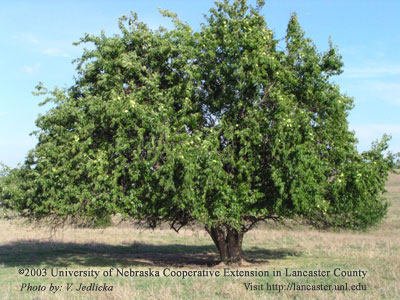Attention! This site is not yet fully operational, but will be soon enough. If you have some orders for osage lumber you need filled, head over to the 'contact us' section and specify what you need. The Osage Orange Tree Osage-orange, Horse-apple, Bois D'Arc, or Bodark (Maclura pomifera) is a small deciduous tree or large shrub, typically growing to 8–15 metres (26–49 ft) tall. It is dioeceous, with male and female flowers on different plants. The fruit, a multiple fruit, is roughly spherical, but bumpy, and 7–15 cm in diameter, and it is filled with a sticky white latex sap. In fall, its color turns a bright yellow-green and it has a faint odor similar to that of oranges.[1] It is not closely related to the citrus fruit called an orange: Maclura belongs to the mulberry family, Moraceae, while oranges belong to the family Rutaceae. Maclura is closely related to the genus Cudrania, and hybrids between the two genera have been produced. In fact, some botanists recognize a more broadly defined Maclura that includes species previously included in Cudrania and other genera of Moraceae. Osajin and Pomiferin are flavonoid pigments present in the wood and fruit, comprising about 10% of the fruit's dry weight. The plant also contains the flavonol morin. Recent research suggests that elemol, another component extractable from the fruit, shows promise as a mosquito repellent with similar activity to DEET in contact and residual repellency. Description of the tree The trees range from 40–60 feet (12–18 m) high with short trunk and round-topped head. The juice is milky and acrid. The roots are thick, fleshy, covered with bright orange bark. The leaves are arranged alternately on a slender growing shoot 3–4 feet (0.91–1.2 m) long, varying from dark to pale tender green. In form they are very simple, a long oval terminating in a slender point. In the axil of every growing leaf is found a growing spine which when mature is about 1 inch (2.5 cm) long, and rather formidable. The pistillate and staminate flowers are on different trees; both are inconspicuous; but the fruit is very much in evidence. This in size and general appearance resembles a large, yellow green orange; only its surface is roughened and tuberculated. It is, in fact, a compound fruit such as botanists call a syncarp, where thecarpels (that is, the ovaries) have grown together and that the great orange-like ball is not one fruit but many. It is heavily charged with milky juice which oozes out at the slightest wounding of the surface. Although the flowering is diœcious, the pistillate tree even when isolated will bear large oranges, perfect to the sight but lacking the seeds.
Information from http://en.wikipedia.org/wiki/Osage-orange all copyrights reserved |
An Osage Orange Tree  Hedge Apples (A.K.A. Horse-Apples, Monkey Balls, Etc.) Picture Taken from http://homeschooljournal-bergblog.blogspot.com/2010/10/nature-study-osage-orange.html All rights reserved  A Testimonial... "The Osage-Orange tree has to be one of the most spectacular trees that I've come across, not in visualization but in the sheer number of various uses it has, ranging from the custom wood working to the yellow-orange dye made from it, and the insect repelling properties of it's fruit to the fruit's proven cancer fighting properties. This tree is just all around amazing!" -Chris |